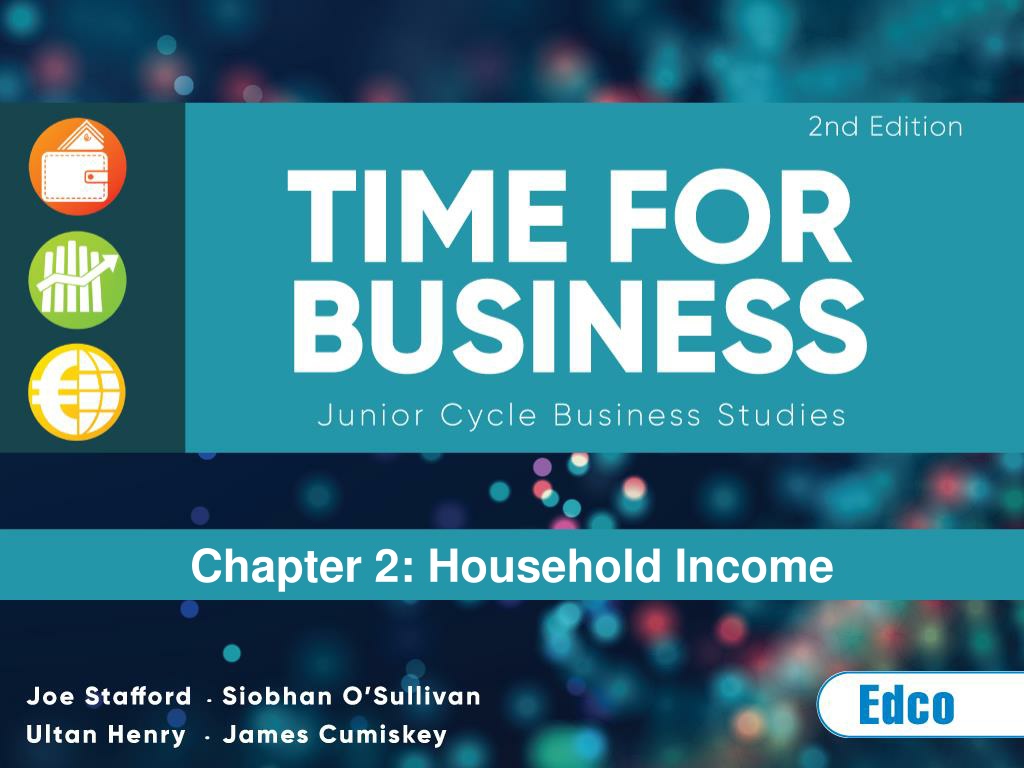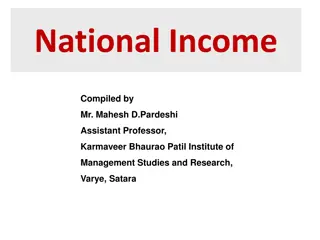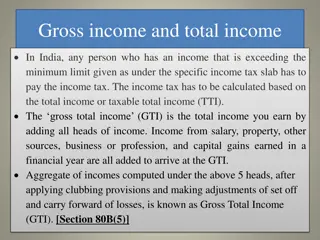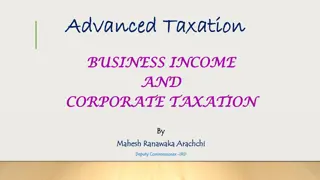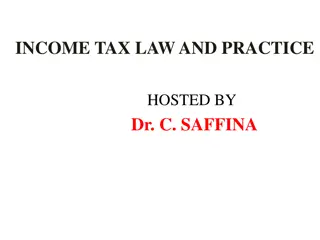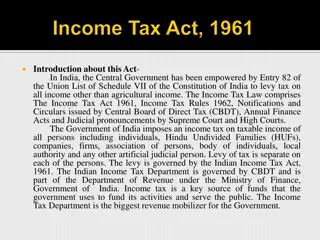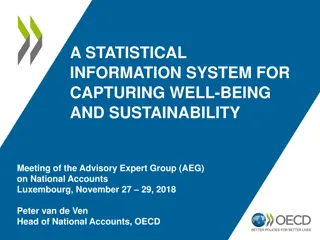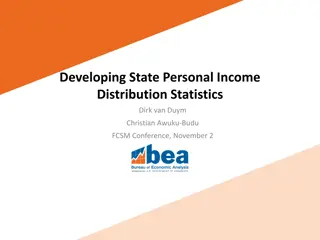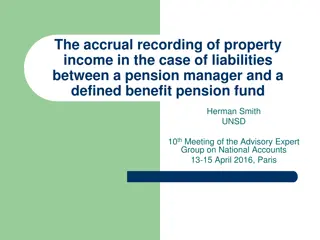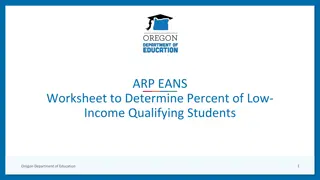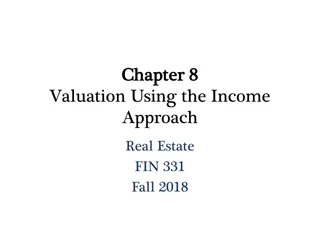Understanding Household Income: Sources, Types, and Management
Explore Chapter 2 on household income to learn about sources like wages, pensions, and benefits, differentiate between regular and irregular income, understand why taxes are necessary, interpret payslips, calculate gross and net income, manage deductions, and create an effective income plan.
Download Presentation

Please find below an Image/Link to download the presentation.
The content on the website is provided AS IS for your information and personal use only. It may not be sold, licensed, or shared on other websites without obtaining consent from the author. Download presentation by click this link. If you encounter any issues during the download, it is possible that the publisher has removed the file from their server.
E N D
Presentation Transcript
Chapter 2 Learning intentions In this chapter you will learn to: State the main sources of household income Distinguish between regular and irregular sources of income Explain benefit in kind income Explain why tax must be paid on income Interpret a payslip Calculate gross and net income Differentiate between statutory and voluntary deductions from income Differentiate between disposable and discretionary income Prepare and evaluate a household income plan. Textbook page reference: 10
Chapter 2 What is income? Income is the money received by a person or a household. Textbook page reference: 11
Chapter 2 Sources of household income Wages and salaries Income received as a reward for work. Pensions Income paid to people who have retired. Child benefit A payment made to parents/guardians of children. Jobseeker s benefit A payment to people who are unable to find employment. Working Family Payment (WFP) A payment available to employees with children. It gives extra financial support to people on low pay. Income from grants A grant is a sum of money paid to someone for a specific purpose. Unlike a loan, it does not need to be repaid. Interest on savings Financial institutions reward those who save money with them by paying interest on their savings. Dividends on shares A dividend is the portion of company profits paid to shareholders. Windfall income This is income that you don t expect, such as a win on the National Lottery or gifts and inheritances. Textbook page reference: 11
Chapter 2 Sources of household income Wages and salaries Pensions Child benefit Working Family Payment (WFP) Jobseeker s Benefit Income from grants Interest on savings Dividends on shares Windfall income Textbook page reference: 11
Chapter 2 Regular and irregular income Some sources of income are received on a regular or ongoing basis, such as weekly or monthly. Other types of income are less predictable and may be received only irregularly. Textbook page reference: 14
Chapter 2 Regular and irregular income Examples of regular income: Wages Salaries Child Benefit Pensions Jobseeker s Benefit Textbook page reference: 14
Chapter 2 Regular and irregular income Examples of irregular income: Overtime Bonus Windfall Textbook page reference: 14
Chapter 2 Benefit in kind Non-money income in the form of benefits in kind (BIK), also known as perks , may be received when the household is provided with goods or services that have a money value, e.g. a company car. Textbook page reference: 14
Chapter 2 Income from employment A salary is a fixed annual payment made to an employee no matter how many hours they work Textbook page reference: 14
Chapter 2 Income from employment A wage is a payment received for work done, normally calculated on the basis of actual work completed or on the amount of time spent working. Textbook page reference: 15
Chapter 2 Income from employment Wages may be calculated using a number of different methods, including: Time rate: Wage calculation based on the number of hours worked. Overtime payments: When an employee works longer than the standard working week they may receive a higher rate of payment for those extra hours. Textbook page reference: 15
Chapter 2 Income from employment Wages may be calculated using a number of different methods, including: Piece rate: Calculation based on the number of items completed. Commission: Some workers, receive a payment based on the value of the goods or services they have sold. Bonus payments: Some employers reward their staff with extra payments for meeting performance targets or deadlines. Textbook page reference: 15
Chapter 2 Income from employment Basic pay is the amount earned before any extra payments (overtime and bonuses) are added. Textbook page reference: 15
Chapter 2 Payment received Gross pay = Basic pay + Overtime + Bonuses + Commission earned Gross pay is the sum of basic pay plus any extra income earned from overtime, bonuses or commission. In other words, the total pay before any deductions. Textbook page reference: 16
Chapter 2 Payment received Net pay = Gross pay Total deductions Net pay, also called take-home pay , is the amount left after all deductions from gross pay. Textbook page reference: 16
Chapter 2 Deductions There are two main types of deduction from pay: Statutory deductions are compulsory. Every worker is required by law to pay. Voluntary deductions are not compulsory, but workers may choose to pay them. Textbook page reference: 16
Chapter 2 Statutory deductions Pay As You Earn (PAYE) income tax system. Under this system, tax is paid on income as it is earned. Pay Related Social Insurance (PRSI), allows employees to claim certain benefits in the future, if needed, e.g. a state pension. Universal Social Charge (USC), applies to all workers whose income is above a certain limit and is used to fund government spending. Textbook page reference: 16
Chapter 2 Disposable income The remaining income after all income taxes and statutory payments have been made is called disposable income. Textbook page reference: 17
Chapter 2 Discretionary income The income left over after taxes and essential spending on items such as the food and bills is called discretionary income, and you can choose how to spend it. Textbook page reference: 18
Chapter 2 Textbook page reference: 16 18
Chapter 2 Income calculation By law, employers must provide employees with a payslip, either on paper or electronically, to show the amounts earned and deducted. Textbook page reference: 19
Chapter 2 Planning and recording income Households can use a cash book to keep and analyse records of actual income received. Textbook page reference: 19
Chapter 2 Recap and Review Can you? State the main sources of household income? Distinguish between regular and irregular sources of income? Explain benefit in kind income? Explain why tax must be paid on income? Interpret a payslip? Calculate gross and net income? Differentiate between statutory and voluntary deductions from income? Differentiate between disposable and discretionary income? Prepare and evaluate a household income plan?
Chapter 2 Credit slide Shutterstock
